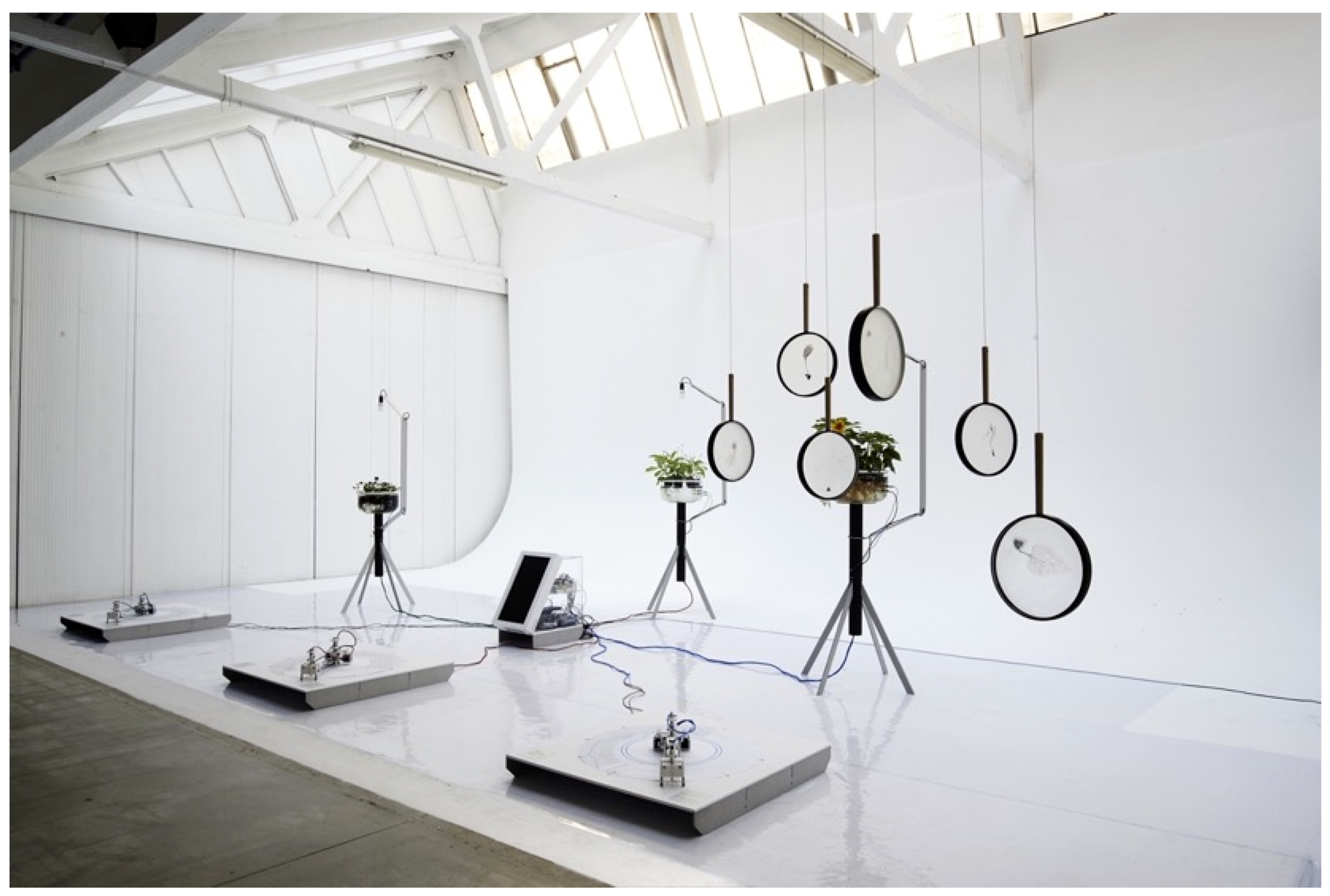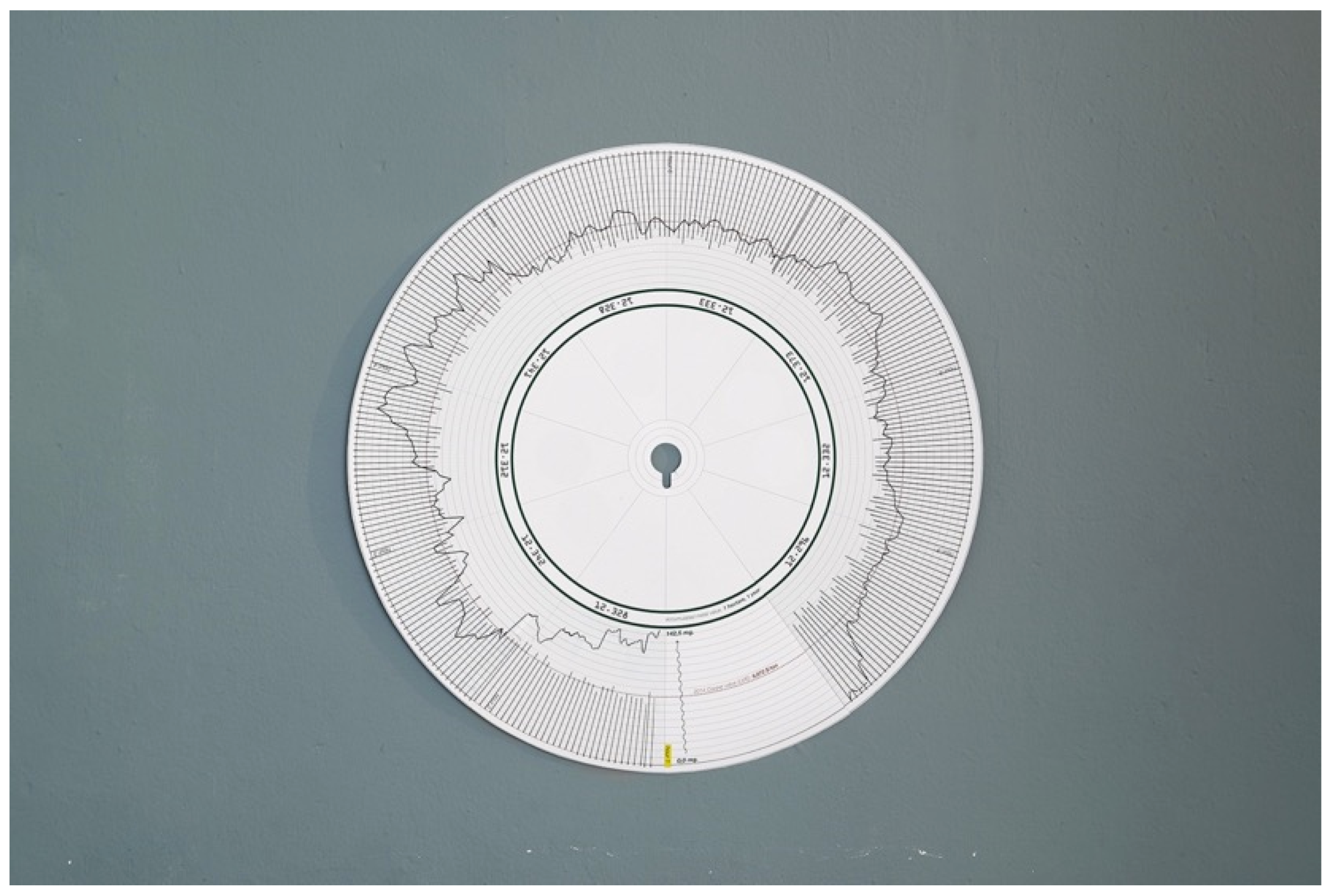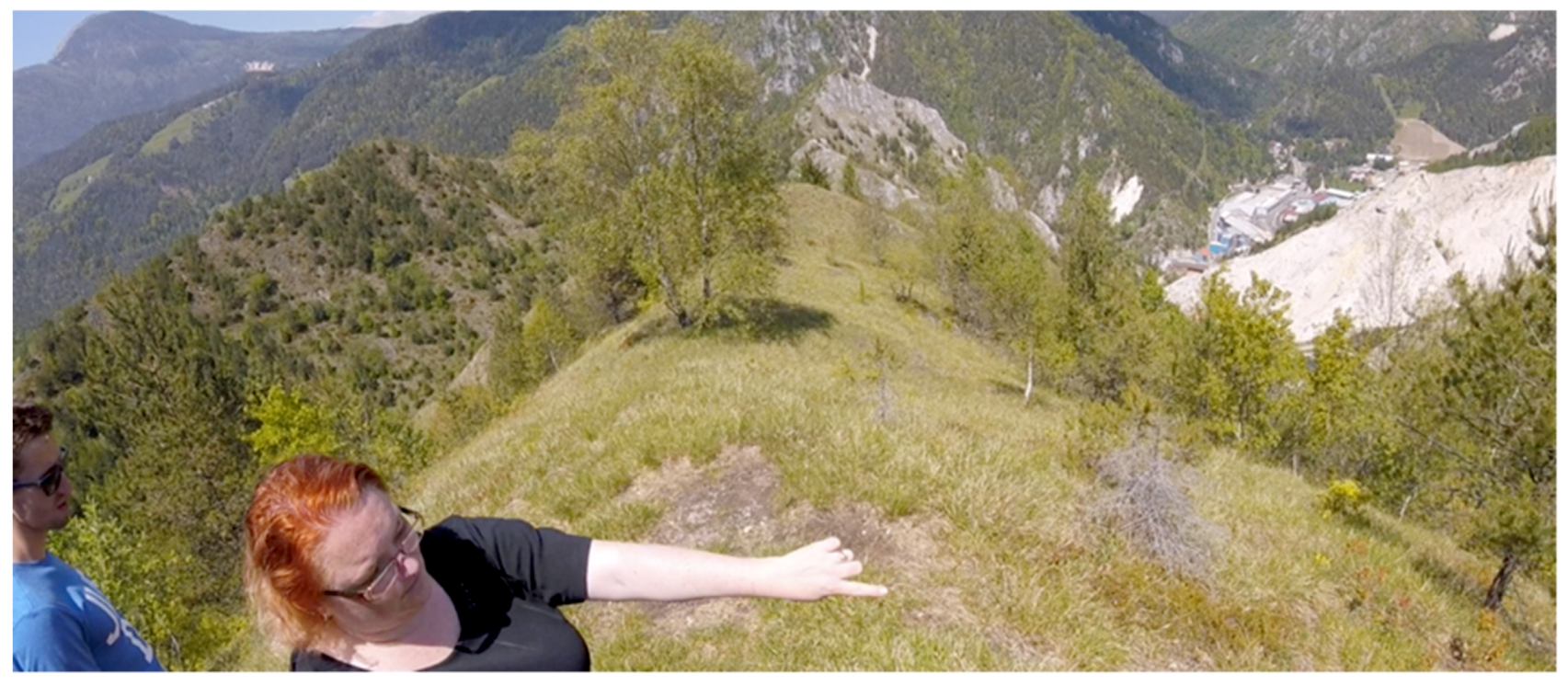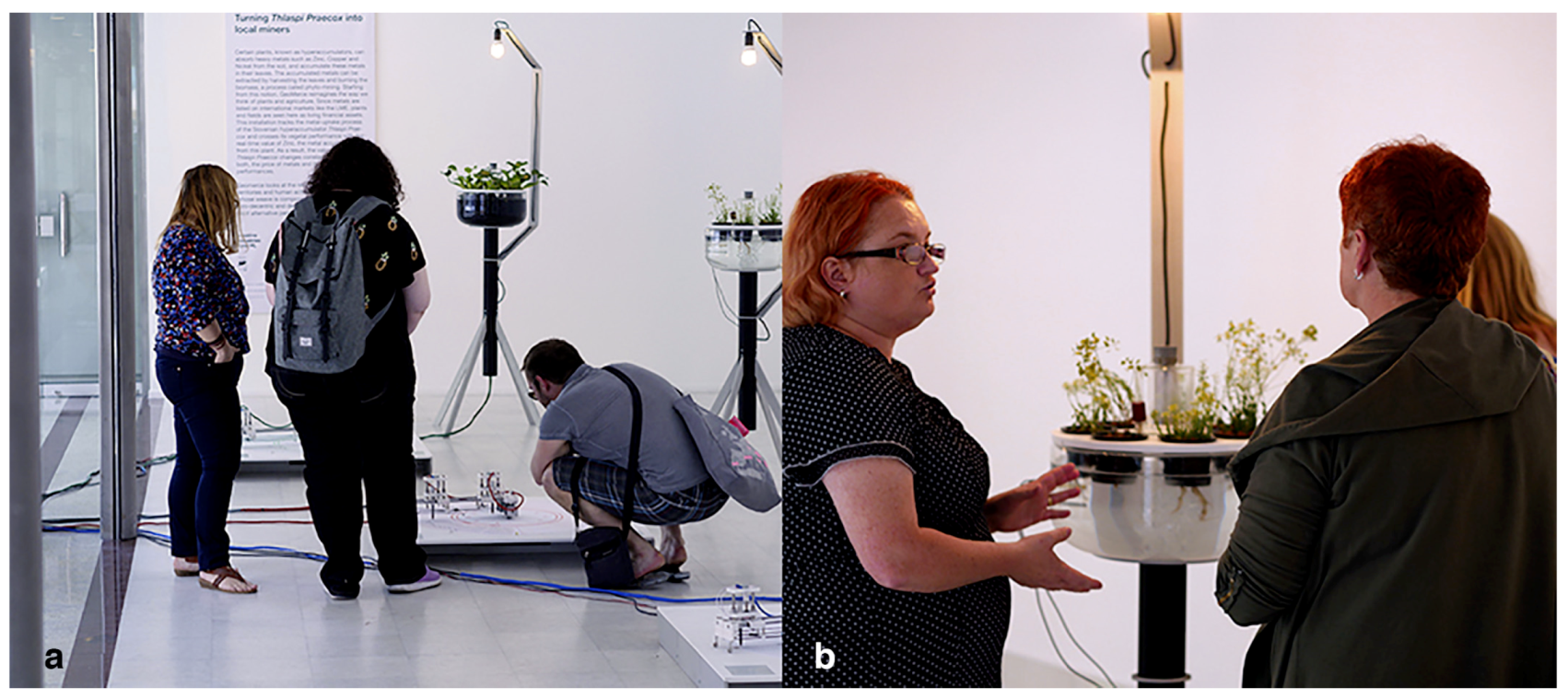3.1. Following the Thlaspi in the Lab
The visit to the plant biology department was planned two weeks before the beginning of BIO25. The aim was to become familiar with the plants researched by the scientists and approach their laboratory work. For several years, the focus of the scientists had been on the species
Thlaspi praecox (
Figure 5a,b). The plant is just one of the many ecotypes of
Thlaspi that accumulates heavy metals. It was identified from the lab’s director in 2005, from some green areas in the vicinity of the former mine of Zerjav. The soil there was deeply affected by zinc, lead, and cadmium contaminants, which is a feature that actually facilitated the adaptation mechanisms later found in the Thlaspi, as the plant has the unique capacity of accumulating all of the three metals [
41]. As in similar metallophytes, the plant uses the toxicity of heavy metals as a mode of protection and self-defence from external agents such as insects and parasites [
43,
44].
Part of the visit was spent inside the lab’s greenhouse, where the physiological traits of multiple Thlaspi could be experienced more closely. Dozens of plant ecotypes collected from different Slovenian and Austrian places were arranged in multiples rows and individually labelled using text and symbols. In being there, each plant functioned as another-than-human witness of the disturbance history that emerged from the past of a specific territory. The ecotype from Zerjav was grown on a calcareous substrate, so as to replicate its original habitat and facilitate the contingent responses of the plant to technogenic debris.
The experience at the lab also revealed that the expertise of the scientists was politically collocated there, due to the environmental issues that affected part of Slovenia in the previous years. Back in 1998, in fact, the team of biologists gained governmental support to start a new research in the Mežica valley. One of the scholars involved in that project argued that, in those years, applied ecology become very important for the Slovenian government, because the inhabitants of the valley gr[e]w their food on that soil and a third of the children suffer[ed] from heavy diseases and ha[d] more lead in their blood than allowed. Therefore, soil restoration became an issue of political urgency, which motivated those scientists’ expertise on the Thlaspi and their surrounding territory.
3.2. Following the Thlaspi in the Field
The knowledge of the scientists and their wish to participate to Geomerce’s landing at Ljubljana motivated the lab’s director to organise a temporary research team, whose aim was to return to the Metzica valley to find, observe, and sample new specimens of Thlaspi to be included in the installation. Since the land had been once owned from a mining company, and was currently owned by a battery factory, it was not possible for us to cross its perimeter without an authorisation, which we did not have. How, then, to geolocalise the plants, in areas outside of the mine’s territory? What sort of contamination narratives did we need to consider, in order to trace the deposition of heavy metals on the soil?
With the support of the lab’s director, it was decided to follow the plant through geo-speculations [
33] that involved the invisible, and yet traceable aerial dissemination of metal pollutants. An interesting aspect, as it was explained from the scientist, is that the contamination on that site was aggravated by the aerial dispersion of mining debris. During most of the mining period, the chimneys of the former smelting site (
Figure 6a,b) operated without adequate filters, and their fumes were windblown across the land above the mine, contaminating the soil with heavy metals and sulphur dioxide. The latter in particular was the main factor responsible for the degradation of the land, in that it contributed to form acid rains that deteriorated the soil. To complicate matters, the area was subjected to strong thermal inversions, even during the years of mining activity. At that time, the morphology of the environment kept the polluting debris on the valley’s floor; however, from time to time and depending on temperature and wind changes, the smelter’s dusts were blown till its highest limits, affecting the composition of the soil. Those atmospheric patterns led to the hypothesis that, these days, the
Thlaspi praecox could colonise the valley’s apex rather than its inside, in response to the aerial dispersion of mining debris. The walk that was planned with the scientist aimed at exploring such hypothesis—that is, at witnessing the presence of the Thlaspi on the land as a vegetal mode of interacting with the aerial dispersion of mining by-products.
The activity was performed on 22 May 2017, three days before the official opening of BIO25, and was documented using a wearable action camera. The team included six scientists (one of whom was the lab’s director) and a designer (this paper’s first author). To reach the area where, according to the initial hypothesis, a population of
Thlaspi could be found, the Zerjav valley was accessed from south, walking along an alpine path. Within a one-hour walk, the path led to a narrow ridge that overlooks the village and the battery factory that superseded the mining infrastructure years earlier. From there, as anticipated by the scientists, the environmental effects of years of mining operations were clearly visible (
Figure 7). What looked green and lively no longer than a decade earlier was bear rocky land, due to high level of contaminants that precluded a survival of the vegetal ecosystem. That was also able to be experienced by observing the differences between the inside of the valley—where the vegetation just started to take over, and its outside—dominated from healthy spruces and other trees that were not affected by anthropogenic disturbances. It was from there that we began to ‘follow the Thlaspi’, exploiting the ecological knowledge of the scientists to perform observations along the ridge.
The ecological succession in the valley started a few decades earlier with weeds that belong to the Brassicaceae family. The yellow flower buds of
Erysimum sylvestre—an accumulator of zinc, copper, lead, and cadmium [
45], and specimens of
Biscutella laevigata—which specialise in uptaking lead, cadmium, and thallium [
46] carpeted the entire area. Once those plants began to colonise the land, years earlier, other grasses—such as the
Sesleria Caerulea—appeared in the ecosystem, as the result of a tolerance mechanism developed in response to the metal contaminants. Those plants, according to the lab’s director, could prosper there by virtue of the alliances that they managed to form with the underground mycorrhizal network. As a symbiotic organism, the mycorrhiza facilitated the growth of the plant, especially for those species that managed to conquer the land. Furthermore, in exchange for nutrients, the mycelium protected the plants from heavy contaminants such as cadmium, which is considered a toxic element even for the strongest species. The last vegetal arrivals in the ecosystem, the spruces, visually demonstrated the aftermath of a ‘late’ response to that symbiotic negotiation. Some of those conifers managed to survive; however, the signs of toxicity on their foliage witnessed all their efforts in remaining alive.
Near the end of the ridge, in proximity of the areas subjected to thermal inversions, grew a population of Thlaspi praecox. The plants were distributed across the inner side of the valley, between grasses and rocks, forming a bed of small, white flowers. The population was small; some of the individuals did not even exceed the height of 10 centimeters. The biologist explained the phenomenon as a lack of nutrients in the soil, which occurred as a result of decades of acid rains. That part of the ridge became the sampling site from where we collected different exemplars to be later tested in Geomerce.
3.3. Following the Thlaspi in the Showroom
Inside the gallery, Geomerce was displayed as a solo exhibition, with an area dedicated to the project and another to activities such as presentations and debates, where members from the public could vocalise their own experience of the design. The strategy used to communicate Geomerce’s landing at BIO25 relied on a multi-modal format. First, there was a joint press release from the two organising institutions: the Museum of Architecture of Ljubljana (the organiser of the event), which counted on a well-established network of contacts in the field of art and design, and Galerja Kresija, which reached a more general public. Second, there was coverage from journalists, such as national TV programs and design editorialists. Last, Geomerce was advertised by means of a printed flyer that was distributed door-to-door to the citizenship of Zerjav, introducing the installation to potential audiences and attracting people interested in the topic. This multi-modal strategy allowed communicating the installation at its best, as it targeted different publics, triggering about 550 visitors in four days.
In the showroom,
Geomerce displayed the relationships that existed between the extraction performances of the collected plants and the settings of the former mine’s territory. The main hydroponic unit contained: four specimens of
Thlaspi praecox, two of
Biscutella laevigata and one of
Erysimum sylvestre (
Figure 8a), all collected during the fieldwork. The other two units were filled using species that grew on different sites (
Eichhornia Crassipes and
Helianthus Annuus), as a way of comparing the abilities of endemic and non-endemic metallophytes. A suitable hydroponic medium for all plants was identified through the support of a scientist from the lab; this consisted of a solution of deionised water with a mix of different nutrients and 195 milligrams of zinc sulphate, which was added manually to the medium (
Figure 8b). The performance of
Geomerce lasted four days, in each of which were printed three infographics relating to the different groups of plants included in the three hydroponic units. In order to understand the data, at the end of each day, the prints were removed from the plotters and compared to each other. During the first three hours of the opening day, Geomerce’s graphics showed that the decrease of zinc sulphate from the hydroponic medium of the plants from Zerjav was relatively low (13.3 mg/3 h). However, at the end of the ninth hour the hydroponic solution had lost 1/4 (52.71 mg) of the total diluted zinc. During the following two days (days 2 and 3), the sensors continued to monitor a steady decrease of metal from the substrate: 41.49 mg of zinc at the end of the second day, and 61.1 mg of zinc at the end of the third day. It was observed that during those days, the physiological condition of the plants remained the same: the turgidity, shape, colour of the leaves, and root system, accompanied by a growing extraction performance, suggested that the hyperaccumulators interacted well with the hydroponic environment. The performance continued that way until the fourth day, when these parameters changed. Before running the installation, on the morning of day four, the hyperaccumulators were found in conditions of physiological stress. This was also documented in the printed graphs: compared to days 1–3, the amount of metal contained in the substrate did not fluctuate, indicating that the extraction activity of the plants had reduced by 100%. The lab’s director suggested that the cause of that was the lack of nutrients from the substrate: the large amount of heavy metals in the solution, coupled with a low amount of nutrients, turned the water into an alkaline environment, which affected the health of the plants.
From the graphical plots, it appeared that while non-endemic flora absorbed a very small amount of zinc, the hyperaccumulators collected at Zerjav did sequester up to 155.36 mg of the metal out of the 195 mg that was initially dissolved. In crossing vegetal and financial performances, Geomerce suggested that the metallophytes collected at Zerjav had potentially significant mining abilities, which were developed as a response to the peculiarities of their growth site. For the lab’s director, who was interviewed at the end of the exhibition, this reading of the plants’ performance was particularly interesting because it combined the advantages of an in vivo study of the hyperaccumulator with the possibility of speculating about possible applications of phytoremediation as a geographically situated practice. However, from the plant scientist viewpoint, the experiment had also limitations, particularly from a procedural perspective. Particularly, the lack of data concerning the mechanism of metal uptake: was the metal that was deemed to be missing from the solution accumulated by the plants? Or did it just deposit—for instance, on their roots, or on the glass of the hydroponic unit? So far, the project did not provide answers to such questions. Nevertheless, although not explainable in scientific terms, the performance provided valuable inputs regarding alternative ways of investigating the behaviour of endemic flora and evaluating their possible applications in phytomining processes. Indeed, this was viewed by the scientists involved as a useful result, especially to expand the methodologies currently used to investigate those species.
3.4. Public Understandings of Soil Contamination
In order to comprehend the implications of a direct participation of the plant
Thlaspi praecox in
Geomerce, two public activities were planned during the exhibition: a presentation and a debate. The chosen formats mobilised and aggregated different audiences around the project and shed light on the ways in which the participant visitors, through their multiple interactions, engaged with issues of soil contamination. The activities were both planned for the opening day and documented by means of a video clip and pictures taken from two photographers. The presentation was organised according to a standard format, with the designer and the scientist introducing respectively the scientific and design dimensions of
Geomerce (
Figure 9a,b). Although the format was that of a normal speech, the chosen communication method did not require the visitors to remain seated. In keeping the speech informal, with low tables and chairs distributed on the floor and coffees available for the audience, people felt free to roam around the space, engaging with the different elements of the project.
The debate took place straight after the presentation and was also a departure from traditional formats in that it was conceived to dynamically encourage people to interact with the design, inhabiting the scientific, ecological, and socio-political aspects of phytoremediation. It first began as a roundtable with questions and answers, where people could talk and bring along their own experience of environmental pollution. For instance, during the activity, a couple of German visitors introduced the problem of industrial exploitation of soil in the Ruhr region and posed questions to the scientist, who provided her perspective about it. However, as the debate continued, people began to stand up and interact with other public members using the different elements of the installation. In doing so, they split into small groups of interest and spread across the exhibit floor. For instance, two inhabitants of the Mežica valley who received at home the flyer about
Geomerce gathered around the hydroponic unit that hosted the
Thlaspi praecox, to discuss the ecological functions of that species for the territory with the biologist (
Figure 10b). For them, rather than the general presence of flora, it was the performance of that very plant that acquired a particular meaning. In an interview, one of them claimed to have an emotional bond with those plants, as they shared with her an entire life in the valley:
“[...] I particularly observed the plants in the middle,” she said,
“those [that] came from Mežica Valley, because I could relate more to them, having grown up in that area. I could see the activity inside the water bowl, how [...] the plotters moved up and down, annotating the measurements and comparing them against the value of the metals [...]. That really amazed me. [...] I am very attached to the Mežica Valley, and I now have no doubt in my head that it will keep getting better and the environment will be looked after and protected”. Rather than becoming a cause of concern, aspects of geographic territorialisation, coupled with the benefits from financial metal exchange, leveraged on that visitor’s sense of belonging to the territory and the urgency to plan a better future for its inhabitants. Experiencing the real-time performances of
Geomerce brought her to think about alternative agricultural futures for the Mežica valley, which could remediate the soil and at the same time offer opportunities for the generations to come. During the interview, she explained that
Geomerce’s scenario looked to her as an almost plausible future: “
The installation was useful,” the visitor argued
, “because it showed that the economic perspective itself is actually huge, but not only that; also, the impact on the environment and how to clean it are huge, too. And the potential employment opportunities—you would need a lot of people to work for this process, planting, harvesting, and extracting. And—at the end, some money could be made by selling these metals. Other visitors were more interested in the performative dimension of the hyperaccumulating flora, and knelt around the plotters to observe the prints and the activity of the plants (
Figure 10a). An interview with one of them, who was an environmental consultant by profession, revealed that
Geomerce suggested a re-thinking of contamination through the perspective of metallophytes. This way of reading the exhibition brought him to consider the implications of phytomining on a larger, more-than-human scale, reflecting upon factors that he would have otherwise left aside: “
[…] If you think things through”, he claimed,
“you can understand that interaction might not just be intended in one-way—such as phytoremediation but also, from a plant perspective [...] such as humans putting more elements into the environment, which might benefit a plant’s growth. In that sense, it seems as if the purpose was to get people to think differently about plants and our interaction with them as opposed to give them information on a particular application of plants […]. The way you presented it was more about thinking that there is a process happening, which is dynamic and relevant to the market economy. This opens up different parts of the brain and gets people thinking in a more lateral sense.”The format used to exhibit Geomerce—which assembled environmental, scientific, and speculative perspectives on phytomining, and the following debate—which allowed the visitors to tune such perspectives according to their own interests and expertise, brought people to engage in multiple encounter experiences with the performing plants. Those activities did not simply involve the biologist and the designer regarding the quality of experts, but rather assembled a new network of participants, including environmentalists, social scientists, and engineers, who could all exchange ideas, opinions, inform each other, and question the issues raised by Geomerce. Across this interweaving of encounters, the showroom worked as a forum, in which multiple knowledges could flow horizontally among the actors who participated in the event. In an interview, the biologist claimed that the chosen format led to multiple interactions between the participant visitors, who informed each other through their experiences of the territory that they inhabited: “These kinds of interactions”, she argued, “are very useful. First, you get people with different knowledge. [Through] that, you are enriched, and you enrich them. For instance, people can become aware of living in a polluted environment and that certain vegetables shouldn’t be grown there, as they would become intoxicated. This would be important to improve the quality of life, and it’s only possible through this kind of debate. Furthermore, if you meet people, if you talk with them and exchange opinions, then their experience becomes your experience, as you carry that with you and start to think about it. Many people informed me about their own individual experiences, and those are the people who thought about possible mechanisms to improve things in the territory. Meeting them, their views, what they think […] is a sort of mode of evaluating the usefulness of my work.” During those interactions, it was observed that the visiting audience, in addition to familiarising themselves with plant research, also started to refer differently to plants. While gathering around the hydroponic units, a couple of participants asked if touching hyperaccumulators could be dangerous, others asked if the performance induced stress to the plants, others became curious to know what would happen to the specimens once the exhibition ended, offering to adopt the species to re-pot them in their garden. In this sense, the multispecies design installation with performing plants showed the potential of bringing people closer to other-than-humans, by means of experiences that reveal the hidden vitality of living flora.













